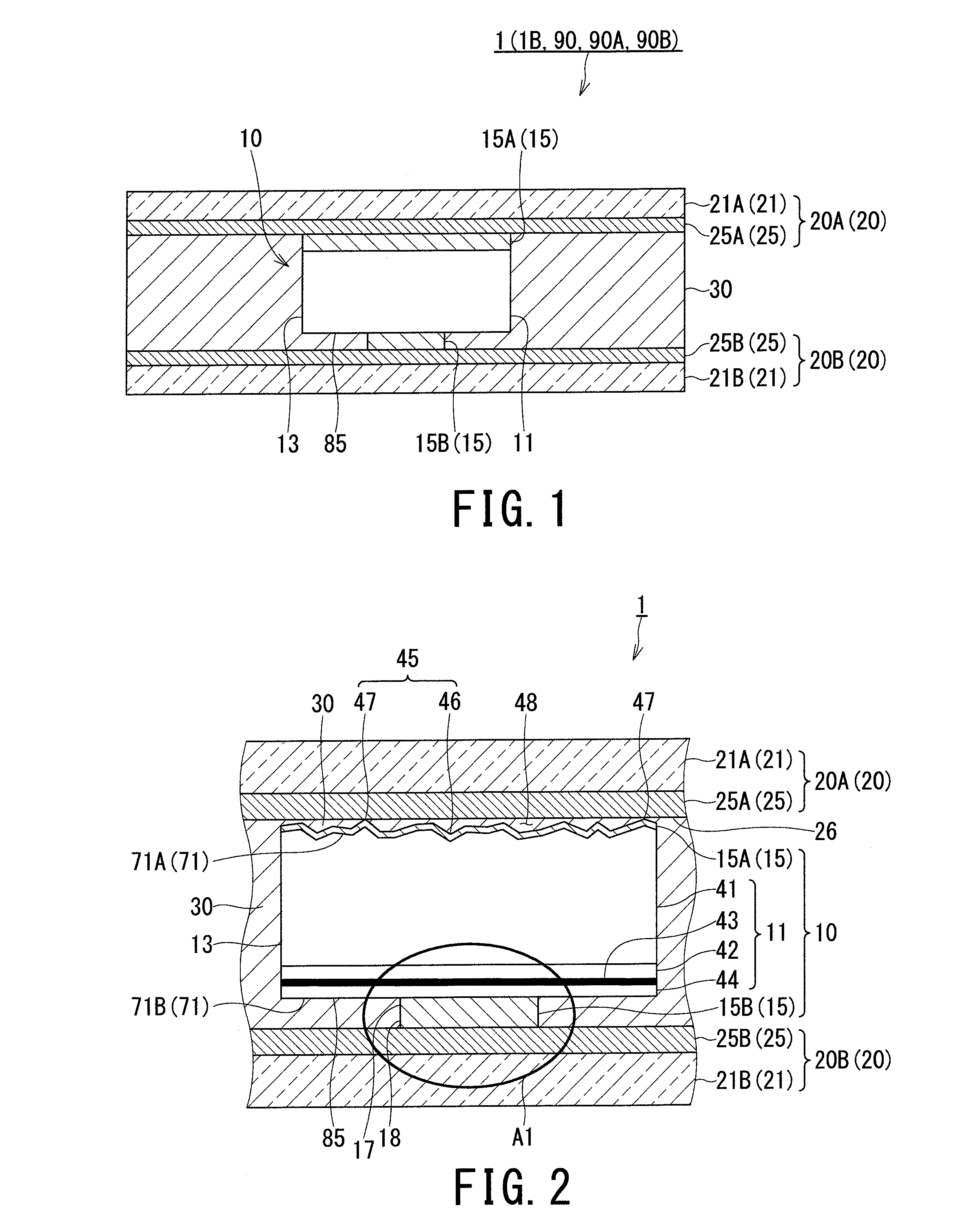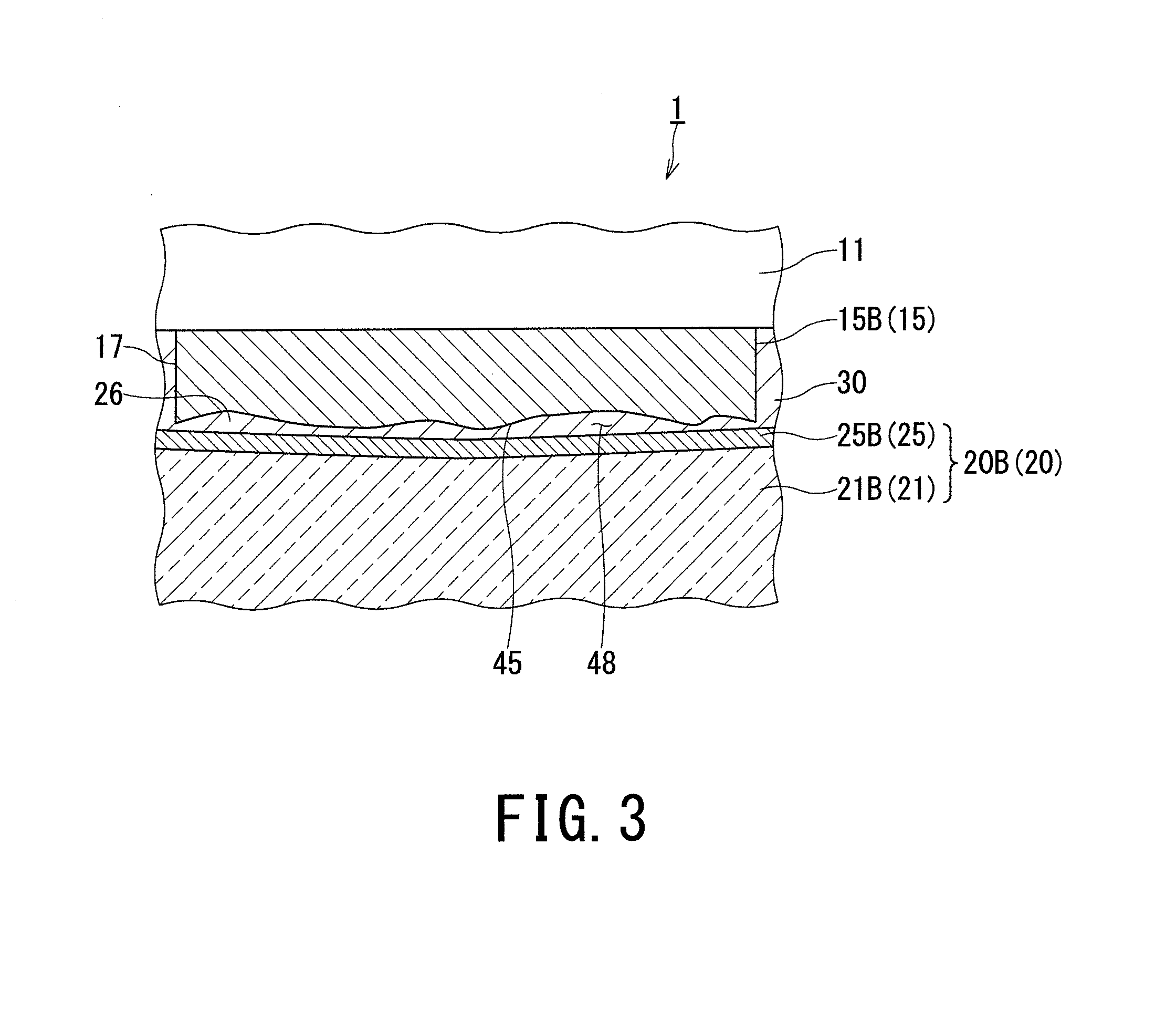Light-emitting device, production method therefor, and device using light-emitting device
a technology of light-emitting devices and production methods, which is applied in the direction of semiconductor devices, electrical equipment, chemistry apparatus and processes, etc., can solve the problems that the conventional use of wirebonding methods is not desirable as a connection method, and achieve excellent flexural resistance or heat-cycle characteristics, prevent cracks or breakages, and improve adhesion
- Summary
- Abstract
- Description
- Claims
- Application Information
AI Technical Summary
Benefits of technology
Problems solved by technology
Method used
Image
Examples
first embodiment
[0052]FIG. 1 is a sectional view of an essential part of a light-emitting device according to a first embodiment.
[0053]A light-emitting device 1, includes: an LED chip 10 including an LED body 11 and first and second electrode layers 15 (15A, 15B) formed on a front and a back face, respectively, of the LED body 11; first and second light-transmissive electroconductive members 20 (20A, 20B) respectively covering the LED chip 10 and including transparent substrates 21 (21A, 21B) and first and second light-transmissive electroconductive layers 25 (25A, 25B); and a light-transmissive elastomer layer 30 joined to a circumference 13 of the LED chip 10 and also to the light-transmissive electroconductive layer 25A of the light-transmissive electroconductive member 20A and the light-transmissive electroconductive layer 25B of the light-transmissive electroconductive member 20B.
[0054]In short, the light-emitting device 1 is formed by sandwiching the LED chip 10 with two sheets of the light-t...
second embodiment
[0147]FIG. 14 is a sectional view of a light-emitting device of a second embodiment. Compared with the light-emitting device 1 shown in FIG. 1 as a first embodiment, the light-emitting device 1A is different in that it includes an LED chip 10A having two types of electrodes 15A and 15B on one face thereof in place of the LED chip 10, a transparent substrate 21D having no light-transmissive electroconductive layer 25 in place of the first light-transmissive electroconductive member 20A, and a light-transmissive electroconductive member 20C having two types of light-transmissive electroconductive layers 25A and 25B in place of the second light-transmissive electroconductive member 20B, and the other structure is identical to the light-emitting device 1. Accordingly, with respect to the light-emitting device 1A shown in FIG. 14 as a second embodiment, the same components as those in the light-emitting device 1 shown in FIG. 1 as a first embodiment are denoted by identical symbols or nu...
example 1
Two-Face Electrode-Type LED Device
[0227]A strip-shaped LED device having a general structure including a length of about 90 mm and a width of about 50 mm was prepared by disposing six two-face electrode-type LED chips connected in series and arranged in a straight line with a spacing of about 5 mm from each other and disposing a pair of elastomer sheets respectively over the two faces of electrodes, followed by sandwiching with a pair of light-transmissive electroconductive member sheets and hot vacuum pressing. A partial laminate structure thereof was similar as shown in FIGS. 1 and 2. Details thereof are described below.
(LED Chip)
[0228]As LED chips, GaAlAs / GaAs-based red luminescence LED chips (planar size: about 300×300 μm, whole thickness (height): 175 μm) having electrodes on both front and back faces, were provided. The electrode layers on both faces of each LED chip included a substrate side electrode layer (15A) comprising a 3.5 μm-thick Au layer electrically connected to an...
PUM
 Login to View More
Login to View More Abstract
Description
Claims
Application Information
 Login to View More
Login to View More - R&D
- Intellectual Property
- Life Sciences
- Materials
- Tech Scout
- Unparalleled Data Quality
- Higher Quality Content
- 60% Fewer Hallucinations
Browse by: Latest US Patents, China's latest patents, Technical Efficacy Thesaurus, Application Domain, Technology Topic, Popular Technical Reports.
© 2025 PatSnap. All rights reserved.Legal|Privacy policy|Modern Slavery Act Transparency Statement|Sitemap|About US| Contact US: help@patsnap.com



